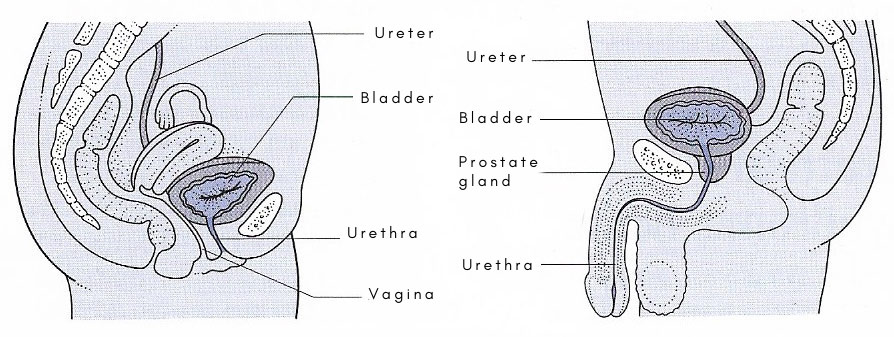urethra

The female urethra (left) is short (about 4 cm long) and runs down to open to the exterior just in front of the vagina. The male urethra is about 18–20 cm long. It passes through the prostate gland and along the full length of the penis.
The urethra is the final passageway for the flow of urine out of the body. The urethra is a thin-walled tube that conveys urine from the floor of the urinary bladder to the outside. The opening to the outside is the external urethral orifice. The mucosal lining of the urethra is transitional epithelium. The wall also contains smooth muscle fibers and is supported by connective tissue.
The internal urethral sphincter surrounds the beginning of the urethra, where it leaves the urinary bladder. This sphincter is smooth (involuntary) muscle. Another sphincter, the external urethral sphincter, is skeletal (voluntary) muscle and encircles the urethra where it goes through the pelvic floor. These two sphincters control the flow of urine through the urethra.
In females, the urethra is short, only 3 to 4 centimeters (about 1.5 inches) long. The external urethral orifice opens to the outside just anterior to the opening for the vagina (see genital tract).
In males, the urethra is much longer, about 20 centimeters (7 to 8 inches) in length, and transports both urine and semen. The first part, next to the urinary bladder, passes through the prostate gland and is called the prostatic urethra. The second part, a short region that penetrates the pelvic floor and enters the penis, is called the membranous urethra. The third part, the spongy urethra, is the longest region. This portion of the urethra extends the entire length of the penis, and the external urethral orifice opens to the outside at the tip of the penis.
Disorders of the urethra
Urethral infections, scarring, and congenital abnormalities occur in both sexes, but these are much more common and serious in males than in females. Inflammation of the urethra, called urethritis, may be due to an infection such as chlamydia or gonorrhea, irritation, or minor surgery. It may lead to urethral structure (narrowing of a section of the urethra) in men. In addition, the male urethra is easily damaged in accidents involving pelvic injury and may require surgical repair.
Male infants sometimes have a urethral valve, which is a flap that grows from the lining of the urethra. The valve impedes the flow of urine and causes back pressure on the kidneys as urine overfills the bladder, ureters, and collecting ducts of the kidneys. Permanent and severe damage to the kidneys can occur if the urethral valve is not removed surgically.


